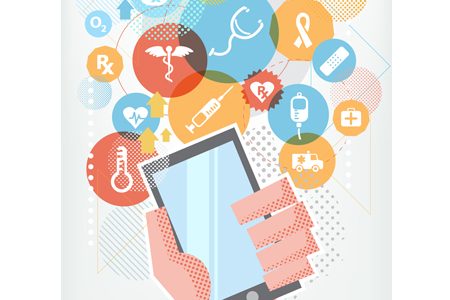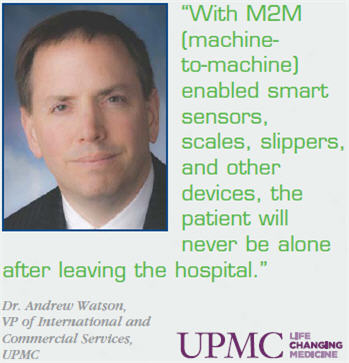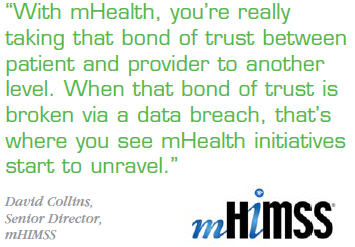The Rise Of mHealth
By Ken Congdon, Editor In Chief, Health IT Outcomes
Healthcare is currently wrapped in a cloud of mobility, but what applications hold the most promise for providers and their patients, and what does the future hold?
One need look no further than the local Apple Store or Verizon Wireless shop to see just how mobile our society has become. Consumer demand for wireless devices and applications is one of the main reasons mobility has been so readily adopted in the healthcare industry. Unlike EHR initiatives, which are often met with opposition by clinicians because of the workflow disruptions they can create, mHealth initiatives are often spearheaded by physicians because of the convenience they can provide. Clinicians want to access health data and communicate with patients and staff without being tethered to their offices. This freedom allows them to be more productive while providing better care to their patients.
 Recent data shows just how pervasive mobility has become among healthcare providers. A 2012 HIMSS Health IT Report shows that 80% of physicians surveyed own tablet devices. This is more than double the adoption rate of the average consumer, and it is only expected to expand. It’s also clear that mHealth adoption doesn’t end with the clinician — providers are involving patients as well. For instance, a 2012 Mobile Technology Survey by HIMSS Analytics indicates that 1/3 of healthcare organizations are allowing patients to access health information using a mobile device. This data bodes well for mobile device manufacturers and mobile software developers, but what does it mean for the future of healthcare delivery? What promise does mHealth offer providers and patients that is contributing to this meteoric rise? To understand this, we first have to have a clear understanding of mHealth.
Recent data shows just how pervasive mobility has become among healthcare providers. A 2012 HIMSS Health IT Report shows that 80% of physicians surveyed own tablet devices. This is more than double the adoption rate of the average consumer, and it is only expected to expand. It’s also clear that mHealth adoption doesn’t end with the clinician — providers are involving patients as well. For instance, a 2012 Mobile Technology Survey by HIMSS Analytics indicates that 1/3 of healthcare organizations are allowing patients to access health information using a mobile device. This data bodes well for mobile device manufacturers and mobile software developers, but what does it mean for the future of healthcare delivery? What promise does mHealth offer providers and patients that is contributing to this meteoric rise? To understand this, we first have to have a clear understanding of mHealth.
DEFINING mHEALTH
Like many buzzwords that have come before, mHealth means something different to just about everybody. Some people use it as an all-encompassing term to represent everything from mobile computing to video conferencing and remote monitoring. Others have a narrower definition of mHealth, using it strictly to refer to the world of mobile health apps.
To date, there is no universally accepted definition of mHealth, but a few respected organizations have taken a stab at giving the term meaning. For example, the World Health Organization defines mHealth as “the spread of mobile technologies as well as advancements in their innovative application to address health priorities.” The National Institute of Health, on the other hand, defines mHealth as “the use of mobile and wireless devices to improve health outcomes, healthcare services, and health research.” For Dr. Andrew Watson, VP of International and Commercial Services at UPMC and Medical Director of the Center for Connected Medicine, mHealth can be defined much more simply.

“UPMC has been at the forefront of the mHealth movement, and for us, mHealth is simply the evolution of healthcare into the virtual world (or cloud) using highly portable devices,” says Dr. Watson.
mHEALTH’S ROLE IN COMMUNICATION, COLLABORATION, & POPULATION HEALTH
mHealth has been touted as a means to increase operational efficiencies and decrease the cost of care delivery. However, when you get right down to it, the primary benefit of mHealth is improved care quality and patient empowerment. According to David Collins, Senior Director of mHIMSS, some of the most inspiring applications of mHealth to date focus on providing patients with easy access to better care. For example, Collins references CallDR, a mobile app dedicated to streamlining the consultation process by allowing physicians to securely send patient data (including photos and video) and engage in real-time collaborations with specialists (anywhere in the world) via a mobile device.
“The CallDR app is a great example of how easily mHealth can significantly impact the timeliness of medical care in multiple settings,” says Collins. “Plus, the app was developed by a physician, which is further indication of how mHealth is being embraced by the clinical community.”
Asthmapolis is another mHealth application on Collins’ radar. This solution uses inhaler sensors, mobile applications, advanced analytics, and feedback to help physicians identify those patients who need more help controlling the disease before they suffer a severe and costly exacerbation.
“Asthmapolis provides a glimpse of the instrumental role mHealth will play in the area of population health management,” says Collins. “By capturing unclouded data from the patient in real time via a mobile sensor or device, health providers now can be proactive, rather than reactive, when treating patients. This will go a long way in keeping patients out of the hospital.”
While UPMC’s Dr. Watson shares Collins’ enthusiasm from these innovative apps, he says mHealth is likely to have the most immediate impact by simply enabling better communication between patient and provider. “UPMC has worked diligently to communicate with patients via secure SMS messaging,” says Dr. Watson. “We’ve also established a patient portal that patients can access via their smartphones or tablet devices. This portal allows patients to securely communicate with physicians, review lab results, request specialist consultations, and schedule appointments. Each of these initiatives breaks down barriers between the patient and provider and facilitates care planning and follow up.”
BARRIERS TO mHEALTH ADOPTION
While the promise of mHealth is driving demand, barriers remain that are impeding its universal adoption. Of primary concern are the privacy and security of data transmitted and accessed via mobile devices.
“With mHealth, you’re really taking that bond of trust between patient and provider to another level,” says Collins. “When that bond of trust is broken via a data breach, that’s where you see mHealth initiatives start to unravel. Any negative news involving a health data breach due to a lost or stolen mobile device often outweighs the benefits of mHealth in the public eye. No provider wants to receive this type of negative publicity, so mHealth initiatives are sometimes tabled because of these security concerns.”
Funding questions are definitely another obstacle impeding mHealth adoption. For example, there is some debate over who should foot the bill for consumer- facing mHealth technologies, such as remote monitoring devices and telemedicine solutions — the provider or the patient. No clear reimbursement structure exists for these solutions, and providers still question whether these technologies provide the financial ROI to justify the investment. As such, many health providers are taking a “wait and see” approach before starting many mHealth initiatives.

LEADERSHIP KEY TO mHEALTH SUCCESS
For those providers that accept the barriers but still choose to forge ahead with mHealth projects because of the ultimate value they can provide, there are some widely accepted best practices for ensuring effective mobile solution rollouts. First, health providers need to ensure they have buy-in and representation from all key leaders who will ultimately be involved in implementing and using the mHealth solutions.
For example, Children’s Hospital of Philadelphia has established a dedicated mHealth committee that weighs in on all mobile initiatives under consideration at the facility. This committee is multidisciplinary — including not only C-level and IT executives, but also clinical leaders such as the Chief Nursing Officer and tech-savvy physicians. This committee not only selects technologies, but also outlines policies and usage parameters of how the mHealth solution will be leveraged by the provider and its employees. This strategy encourages adoption, promotes effective use of the tools in play, and helps reduce security risks.
Another best practice is to ensure you have a system in place to stay up-to-date with the ever-changing world of mobile technology. A new mobile device or operating system upgrade seems to be released every month or so. You want to make sure you keep pace with these changes so your mHealth solutions aren’t based on dated technology.
Johns Hopkins Hospital takes a hands-on approach to addressing this issue. Whenever a new mobile device hits the market, the hospital’s IT department purchases it and thoroughly tests it to determine its capabilities and limitations. Based on this evaluation, the Hopkins’ IT staff decides whether or not the device will be added to its mHealth and BYOD (Bring Your Own Device) initiatives.
REMOTE MONITORING DRIVES THE FUTURE OF mHEALTH
While demand for and interest in mobility are certainly high, there’s no question that mHealth is a movement still in its infancy. The healthcare industry has only begun to scratch the surface of how it can leverage mobile technologies to improve operational efficiencies, improve communication, and enhance patient care. Both Collins and Dr. Watson believe advancements in remote monitoring will allow mHealth to have an even more significant impact on the industry going forward.
“Today, when a patient leaves the doctor’s office or the hospital, they are given a treatment plan or discharge instructions, but there is no guarantee that they will follow that plan or call their physician if they have a question or issue,” says Dr. Watson. “With M2M (machine-to-machine) enabled smart sensors, scales, slippers, and other devices, patients will never be alone after leaving the hospital. They will stay connected with their physician in real time via these devices, and doctors will be able to monitor their recovery and intervene if a problem is detected. This level of connectivity will help ensure patients stick to their treatment plans, which will reduce the number of hospital readmissions.”
According to Dr. Watson, mHealth is the natural evolution of healthcare, and it is the inevitable means by which many patient interactions will be conducted in the future. This remains to be seen, but one thing is certain: mHealth has shown the healthcare industry that the face-to-face encounter is not the only way to deliver care. By integrating mHealth, providers can access the timely information needed to improve patient outcomes — all from a virtual location.
